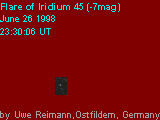 |
by Uwe
Reimann How did I compress the
videos for the Internet?
 The
pictures with the videos are so called "animated gifs", a series of gif pictures
in one file. Gifs are compressed better if there are big areas with the same colour in it. The
pictures with the videos are so called "animated gifs", a series of gif pictures
in one file. Gifs are compressed better if there are big areas with the same colour in it.
 For getting the best compression results, I covered the area, which
contains only black sky (and there- fore the noise of the CCD chip), with a black mask. In
the video on the right I coloured the mask brown, so that you can see it. This trick
avoids that the background noise disturbs the compression. The only reason to do this is
getting a file of acceptable size for your browser to download. For getting the best compression results, I covered the area, which
contains only black sky (and there- fore the noise of the CCD chip), with a black mask. In
the video on the right I coloured the mask brown, so that you can see it. This trick
avoids that the background noise disturbs the compression. The only reason to do this is
getting a file of acceptable size for your browser to download.
 Well, the result you can see on the right. Because of the compression to
an animated gif, the speed of the satellite appears slower than in reality. Well, the result you can see on the right. Because of the compression to
an animated gif, the speed of the satellite appears slower than in reality.

|
 |


  

Areas with noise I covered with black.
Here I coloured the cover brown for you.

|

